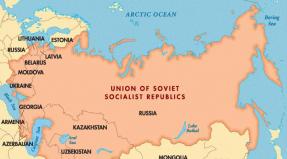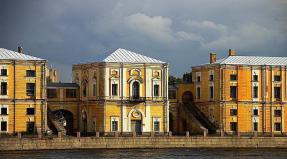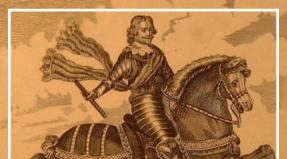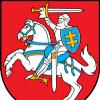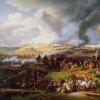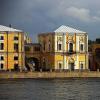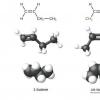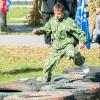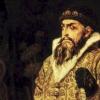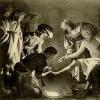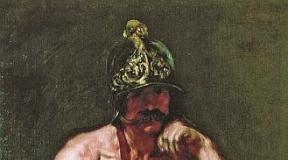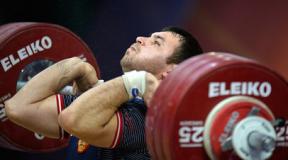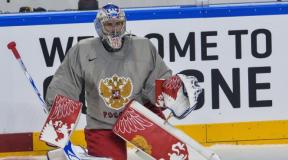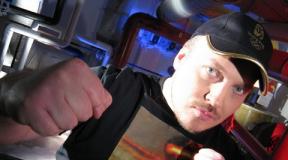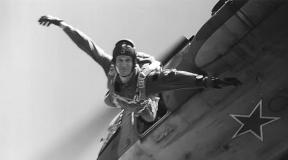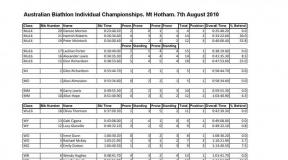The first regular army was formed. How the Russian army was created
It is believed that the Russian army was reorganized according to the European model by Peter I. Is this statement true?
Archers and militias
In fact, the first detachments, armed and organized according to the European model, appeared in Time of Troubles. The backbone of the Russian army at that time was made up of rifle regiments and the noble mounted militia. The noble cavalry did not have a single equipment, battle tactics and was unreliable. There were only about 20 thousand riflemen, and the peculiarities of manning did not allow them to quickly increase their number.
First they recruited "free walking people" - Cossacks, baptized Tatars, noble offspring... Then they recorded mainly Streltsy children. "From the outside" was rarely accepted - in the presence of three guarantors from the regiment. The service was lifelong, but by inheriting the place, one could retire.
Sagittarians were assigned to a specific city. Half - to Moscow. They were paid a small salary annually, but they armed themselves at their own expense. Upon entering the service, they received a land allotment and lifting (about a ruble), for which they were supposed to acquire a subsidiary farm.
When transferred to another place of service, this estate could be sold, and after the death of the owner, it was inherited. This is how a closed class developed, no longer too eager for war. If the archers coped with the duties of peacetime (fire brigades, city guards) and Tatar raids, then they predictably suffered defeats from the Poles.
In 1608 Vasily Shuisky agreed with the Swedes for help. In exchange for the city of Korelu, he received a 15-thousandth corps Jacob de la Gardie , but the government soon ran out of salary money. Only the colonel remained loyal Christer Somme , who began to train the Russian infantry in European linear tactics.
Pikemen of the 17th century 17th century engraving. from "Teachings and tricks of the military structure of infantry people"
Then it was based on the strict interaction of shooters and pikemen, covering the first from the cavalry, and made the troops on the battlefield more mobile. The innovation required from the fighters not outstanding personal data, but memorization of a maneuver. Mushtra made virtually any recruit fit for service. Such shelves were called "Soldiers".
Foreign order shelves

In the late 1620s, Russia was preparing for a new war with Poland. Tsar Mikhail Fedorovich decided to create a new model soldier and reitar regiments (they were also called "regiments of a foreign system"). Colonel was sent abroad Alexandra Leslie to recruit officers and sergeants.
In the early 1630s, the new-style regiment consisted of 1600 lower ranks and 176 "initial men". It was divided into 8 mouths. Of the 200 soldiers in the company, 120 were with muskets, 80 with pikes.
 The battles near Smolensk in 1632-1634. Fragment of an engraving by V. Gondius "The plan of the siege of Smolensk" (1636)
The battles near Smolensk in 1632-1634. Fragment of an engraving by V. Gondius "The plan of the siege of Smolensk" (1636) In total, before the Smolensk war of 1632-1634, 8 soldiers' regiments were formed. Noblemen without an estate and the children of boyars, volunteers from the free estates, were enrolled there, they hired foreigners and forcibly took away "tributary people" from the communities. At the same time, cavalry regiments began to form according to a foreign model - Reitar and Dragoon regiments.
The total number of regiments of the new system was approaching 20 thousand. This was half of the troops assigned against Poland.
Equipment, weapons and salaries were received from the state treasury. Moreover, the soldiers' and dragoon regiments were paid a lump sum of 3 rubles "for a dress." All command positions were still held by foreigners - starting with company commanders and their deputies, and for the Russians there were already lower positions - such as a sergeant or a corporal.
Alexey Mikhailovich began to create even more active shelves of a new type. Under him, they made up more than half of the army and showed themselves excellently in the wars with Poland and Sweden.
In 1681, under the son of Alexei Mikhailovich - Fedora Alekseevich , there were 33 soldier (61 thousand people) and 25 dragoon and reitar (29 thousand) regiments with the number of archers about 55 thousand. Actually, it was already a regular army, which Peter I right in the course of the Northern War, he simply modernized it in accordance with the requirements of the 18th century.
Alexander Gavriluts
The creation of the Russian regular army The 18th century, being one of the most eventful periods of Russian history with military events, was marked by outstanding victories of Russian weapons on land and sea, which raised the international prestige of Russia. These victories would not have been achieved without the presence of a regular combat-ready army and navy in the country. 1 Even in Ancient Russia, there were military formations, the core of which were squads. To solve major foreign policy tasks, to repel the attacks of hostile tribes, the Kiev princes attracted the squads of princes and boyars subject to them, and also convened a militia of warriors, put forward by the population. Allies and mercenaries were also often involved. Subsequent feudal fragmentation also led to military fragmentation. In the XIV-XV centuries, the formation of the Moscow, unified Russian state begins. This period was marked by the first major victory of the united army of the Russian principalities led by Dmitry Donskoy at the Kulikovo field. The integration process continued under Ivan the Terrible, who attempted to create a regular army, carrying out military reform. It was initiated by a decree of October 1, 1550 on the creation in Moscow and surrounding districts of "a chosen thousand of service people." 6 rifle regiments of 500 people each were created. Many historians believe that this period was the beginning of the creation of a standing army in Russia. However, it is inappropriate to link the official date of the emergence of the Russian army with the creation of the first "thousand archers" or other similar dates. The Russian army could and did arise only together with the emergence of the Russian state itself. In addition, the rifle units did not form the basis of the Russian army and did not fully meet the requirements of a standing, regular army. The archers lived in their settlements, were not fully supported by the state and only periodically engaged in combat training, were distinguished by low discipline and poor controllability. Therefore, already in the 16th century, it was necessary to create regiments of a soldier (foreign) system. The creation by Ivan the Terrible of the streltsy troops and regiments of the "new system" by Tsar Alexei Mikhailovich constituted important stages on the way to the creation of a regular army. But these troops existed in parallel and did not yet form a single army. They were not constantly in military service, and even the regiments of the "new order" after the end of the war had to be dispersed to their homes, and then again to collect essentially untrained people. After the Azov campaigns, Peter I was finally convinced that the army that he inherited was unsuitable for solving new more complex military-political tasks. Peter I was faced with the following tasks: to wrest the country out of backwardness, pushing it to the forefront, to carry out as much as possible a whole range of political, economic and military-technical tasks on a national scale, to radically transform the entire military organization of Russia, to reach the coast of the Baltic and Black Seas. To this end, he carried out major reforms in all areas of life and state structure. The most important component of Peter's reforms was a radical reorganization of the military structure of the state and, above all, the creation of a regular army based on a recruitment system. After the rifle revolt of 1699, Peter I ordered to disperse the rifle troops, using the rest of them to serve on the outskirts of Russia. The creation of a regular army required the solution of many issues, the fundamental ones among which were: the creation of a unified system and procedure for the recruitment of troops, their organization and armament, training and education; creation of a state and legislative basis for military service, an economic basis for the country's defense, and the defense industry; development of domestic military regulations; creation of its own national military school. Having solved these issues, Peter I really created a regular armed forces. For the formation of "new instrument" regiments, by the decree of Peter I of November 17, 1699, a "general court" was formed as the supreme body of military control. On June 25, 1700, the new regiments were distributed among divisions and handed over to the commanders of these divisions. In Russian military history, this day was taken as the day of the establishment of the Russian regular army. This date was officially recorded in the "Chronicle of the Russian Imperial Army of 1852" published by the Decree of Emperor Nicholas I. In 1705, by the decree of Peter I, recruiting military service was legislatively consolidated. Its essence was that the army and the navy were annually recruited physically fit for military service men aged 20 to 30 years. The soldier structure was formed from peasants and other taxable estates, and the officer corps - from the nobility. Initially, one person from 20 households was recruited, and from 1724 - 5-7 people from 1000 male souls. Service in the army and navy was lifelong. Thus, a stable system of manning the armed forces with people was created, which was the most advanced for that time. It existed practically unchanged for almost 170 years (until the introduction of universal military service in Russia in 1874). In the first 20 years, 53 recruits were recruited into the army and the navy, which gave 284 thousand. people called up for lifelong military service, of which by the end of the reign of Peter I, 46 infantry regiments (including 2 guards, 2 grenadier), 33 dragoon regiments were formed. The combat strength of the army consisted of 112 thousand people with 480 guns. With the increase in the size of the army and the development of the combat arms, the organizational structure of the troops was improved, which made it easier to control them on the battlefield. A harmonious organization of the Russian armed forces took shape, consisting of a ground army and a navy. The land army consisted of three types of troops - infantry, cavalry and artillery. The main branch of the troops was the infantry, and the main tactical unit, which had permanent staffs, was the regiment. By 1711, the infantry regiment consisted of 8 companies, combined into 2 battalions. For the Russian army, such an infantry regiment staff turned out to be optimal. According to the states of 1711, the infantry regiment had 1487 people, of which 1120 were combatants, 247 were non-combatant ranks, 80 non-commissioned officers and 40 staff and chief officers. The composition of divisions and brigades did not have a permanent structure and changed depending on the situation. The technical equipment of the troops was improved. The infantrymen were armed with a smooth-bore rifle (fuse) with a percussion-flint lock, equipped with a baguette (bayonet). It had a caliber of 7.87 line (19.8 mm) and weighed 14 pounds (5.6 kg). The fusée's aiming range was 250-300 steps, the rate of fire was 1-2 rounds per minute. Now the infantryman in battle could hit the enemy with both fire and a bayonet. The cavalrymen (dragoons) were equipped with a lightweight gun without a bayonet, a broadsword and two pistols. A distinctive feature of the Russian cavalry was that it could operate both on horseback and on foot. The number of its regiments was constantly changing during the war. They were formed depending on the circumstances. According to the states of 1711, it was established to have 33 cavalry regiments, of which 3 were grenadier and 30 fusiliers. The total number of regular cavalry was determined at 43,824 people. The Dragoon regiment consisted of 10 companies, one of which was a horse-grenadier regiment. The companies consisted of 5 squadrons, two in each. The number of the dragoon regiment was determined at 1328 people. The Russian dragoon regiment, in contrast to the European cavalry, had strong regimental artillery. It consisted of 6 or 8 guns. For the first time in Russia was created an equestrian corps - korvolant. It was intended for solving tactical problems and operated during the war in a number of cases at a considerable distance from the main forces of the field army. Artillery has undergone radical changes. The first military unit, which laid the foundation for regular artillery, was the bombardier company of the Preobrazhensky regiment. Then an artillery regiment was created, which united the army field artillery. Its organization and number were constantly changing. According to the state of 1712, the regiment consisted of a bombardier company and 4 gunner companies, a mine company, a pontoon and engineering teams. Under Peter I, artillery began to be divided into regimental, field, siege and serf artillery, which provided ample opportunities for its tactical use. After the defeat at Narva, Peter I did not even regret the church bells, from the metal of which new cannons were hastily cast. The quality of the material part of the artillery was improved, a single caliber scale (Russian artillery scale) was introduced, which eliminated the existing multi-caliber artillery. The guns were of three types: cannons, howitzers and mortars. In the course of Peter's reforms, horse artillery appeared in the Russian army. The system of military command changed radically and became strictly centralized. For this, instead of numerous orders, between which the military administration had previously been fragmented, Peter I established the Military Collegium. Transformations in the system of training and education began with the development of new military regulations and instructions, written on the basis of combat practice in the conditions of the Northern War. The first charter was the "Military Articles" A.M. Golovin, introduced in 1699. In contrast to the regulations of the European armies, they contained only necessary, simple techniques, reorganizations and commands, which were distinguished by clarity of understanding. In 1700, this charter was supplemented with provisions that for the first time established the internal order of army life, the duties of lower ranks and officers. Then new manuals, instructions and regulations appeared: "Company infantry ranks", "Military articles". At the end of 1700, Peter I developed a new charter, which he called the "Brief Ordinary Doctrine", the main idea of which was the need for individual training of each soldier, and for the regular cavalry - the cavalry charter "Dragoon Doctrine", in which the combat training of the infantry and cavalry. In 1709, the troops received the instruction "Establishment for battle to date". Its value lay in the fact that it emphasized the connection between the training of soldiers and officers and the steadfastness of troops, their military valor and dedication, that is, with their moral and combat qualities. A new step in the development of charters was the instruction on tactics of the field army in 1713 - "Rules for a military battle", in which Peter I outlined the issues of maneuvering and control in battle, referring to examples of combat events. This manual summarizes the experience of interaction between infantry and cavalry with artillery units. A special place in this list is occupied by the Military Regulations of 1716, which summarized the combat experience accumulated by the Russian army in the Northern War. It consisted of three independent parts: "Military Charter", "Military Article" and "On Exercise", covered almost all aspects of the life of the army and established an order based on strict discipline and organization in it. The main provisions of this Charter were valid until the end of the 19th century. From November 20, 1721, Russian soldiers began to take an oath of loyalty to the service, obliging soldiers to defend the state "with body and blood, in the field and fortresses, by water and by dry road ...", and officers swore an oath at each promotion in rank. Peter I established military etiquette, and also laid the traditions of the Russian army, raised its moral level. To strengthen the fighting spirit of the army, Peter updated military rituals and ceremonies. To reward those who distinguished themselves, the emperor created a new reward system. A uniform uniform was introduced in the army, and military ranks were established. To train officers, in 1698-1699, a bombarding school was founded at the Preobrazhensky regiment, and at the beginning of the new century, a network of military educational institutions was created: artillery, engineering, foreign languages and even surgical schools. To train non-commissioned officers, there were 50 garrison schools. The internship of young noblemen abroad was widely practiced for training in military affairs. At the same time, the government refused to hire foreign military specialists. In the interval between hostilities, combat training became the main occupation of the army and navy. Peter I is considered the founder of the idea of conducting exercises and maneuvers as the highest form of training for commanders and troops. Thus, the measures taken made it possible to create a powerful, combat-ready regular army, superior to the armies of a number of Western countries. Until the end of the 17th century, the aggregate of military forces in Russia was called the "army" and it was Peter I who introduced the European concept of "army".
The need to create a regular army
The Russian army, created during the reform in the conditions of the grueling Northern War, won numerous victories over a strong enemy. The old armed forces, inherited by Peter from the Muscovy at the beginning of his reign, were unable to accomplish such tasks, which was clearly demonstrated during the Crimean campaigns, and then by the failure at Narva at the beginning of the war.
The armed forces of the Russian state in the 17th century had a structure that was characteristic of an earlier time: noble cavalry, urban (city men) and rural (staff) militia, as well as the streltsy army that appeared under Ivan the Terrible. The local and settled system of maintaining troops, when after the end of hostilities, the nobles returned to the estates, and the archers and staffs to engage in crafts and agriculture, did not contribute to an increase in the combat effectiveness of the armed forces. Legislation of Peter. // Preobrazhensky A. -M., 1997, p. 133
It was traditional to invite foreigners to the Russian service, and since the end of the 16th century this process has been significantly intensified. This made it possible to get to know more closely the Western military order, gradually assimilate their positive experience. From the second half of the 17th century, on the model of Western formations, so-called regiments of a foreign order - foot and horse, were created from the Russians, the commanders and officers of which were foreigners invited to the Russian service. The British and Dutch were the most preferred in hiring, since Russia had long-standing trade relations with these countries. But nevertheless, the majority of the army was made up of local cavalry, armed in different colors and for the most part unsatisfactory.
The times more and more urgently demanded the creation of a professional armed forces of a new type. It was necessary to tear the warrior from the land or craft, to make military service the only source of his existence. Buganov V. Peter the Great and His Time. -M., 1988, p. 237
The beginning of the formation of the regular army
The beginning of the formation of a regular army of a new type was laid by four regiments: Lefortov and Gordon, Preobrazhensky and Semenovsky, which together numbered a little more than 20 thousand people. Created and trained in accordance with Western norms, they became the backbone and forge of personnel for the new Russian army. After the defeat of the Strelets uprising, these formations were almost the only fighting force on which the tsar could fully rely. Many of those who came from them later became officers of other units of the regular Russian army.
In the fall of 1699, the rifle regiments in Moscow were reformed, and a number of Peter's associates were instructed to form three divisions of nine regiments in each, recruiting into which was carried out from dacha people from all over the state, as well as from the "eager" people of Moscow. During the winter of 1699/1700, recruits were delivered to Preobrazhenskoye, where Peter personally, with a list in his hands, determined the suitability of each and distributed them to the regiments himself, which were assigned to command by foreigners who had previously commanded in the regiments of the "foreign system". Officers were appointed either mercenaries who were at the disposal of the Foreign Order, or the Semenovites and Transfigurations, who had undergone good training in the amusing regiments. There was practically no time to train the newly recruited units (only about three months), which resulted in a crushing defeat at Narva. Peter drew the right conclusions from this defeat. It was decided to proceed more actively with the creation of a new regular army, the more the situation was favorable for that, since Charles XII, considering the Russian army finally defeated, turned his main forces against August II. Bagger H. Reforms of Peter. -M., 1985, p. 500
Since 1699, the acquisition principle has changed. The recruitment system is gradually being introduced. Militarily, it was progressive for its time, although it laid a heavy burden on the shoulders of ordinary people. The conditions for the existence of the recruits were unbearably harsh, which led to high mortality and massive escapes.
By the end of the first decade of the 18th century, the active field army consisted of 54 infantry regiments (in their including the guards - Semenovsky and Preobrazhensky) and 34 cavalry regiments. Borders and cities were guarded by the so-called garrison regiments - 2 dragoons and 40 infantry, which were formed partly from the former regiments of the "foreign system", and partly from the archers 2.
As for the number and distribution of personnel within each branch of the military, the situation here has changed over time. The infantry was divided into two types - grenadiers and fusiliers. By 1710, in addition to two guards regiments, 5 grenadier and 47 fusilier regiments were formed. After the victory at Poltava, it was decided to have only 42 field infantry regiments: 2 guards, 5 grenadier and 35 fusilier regiments. The rest of the field regiments were to be disbanded. The staffs of the regiments changed. Until 1704, the regiment had 10 fusilier companies and only a few - 9 fusiliers and 1 grenadier. Since 1704, all regiments had 8 fusilier companies and 1 grenadier company. Since 1708, after the unification of all the grenadier companies into special regiments, 8 companies remained in the field regiments, which were reduced to 2 battalions. Only the Semenovsky, Preobrazhensky and Ingermanland regiments had a three-battalion composition (12 companies). According to the states of 1711, the number of the infantry regiment was 1487 people. According to the states of 1720, the number remained almost the same (1488 people), but the ratio of combatant and non-combatant ranks in the regiment changed somewhat. This situation is typical for the main body of the Russian infantry, if you do not take into account some special formations.
A similar process was going on in the cavalry. In 1702, 10 dragoon regiments were formed, in 1705 - the life regiment (the first guards cavalry regiment). According to the states of 1711, it was determined to have 33 dragoon regiments, not counting the life-regiment, whose staff consisted of 10 companies (a total of 1328 people in the regiment). According to the states of 1720, 33 dragoon regiments and a life regiment remained in the cavalry. Among the 33 field regiments, 3 were grenadier and 30 fueler. The number of the regiment was 1253 people. In 1721 the life regiment was transformed into a private dragoon regiment. Legislation of Peter. // Preobrazhensky A. -M., 1997, p. 134
The first regular part of the artillery was the bombarding company of the Preobrazhensky regiment. In 1701, a special artillery regiment was formed, consisting of cannon companies and four bombardment teams, which also had a pontoon and engineering company and assigned ranks. The solid state of the regiment was determined in 1712. Now it consisted of one bombardier and four cannoneer companies, pontoon and engineering teams, and regimental ranks. For the states of 1723, the structure remained the same, but the number of people increased. All artillery was divided into regimental, field and siege artillery. The regimental was part of the field, but was attached directly to the regiments.
At the same time, the unification of weapons of all types of troops was carried out, a single military uniform was introduced. The transition to linear tactics, which in Russia had specific features 2, is coming to an end.
Thanks to such transformations, Peter in a short time managed to create a mobile, well-organized and well-armed regular army. Such a system, despite minor changes, was extremely cumbersome and inconvenient, especially at the level of local territorial administration. All this required the most radical reorganization. Buganov V. Peter the Great and His Time. -M., 1988, p. 239
The regular Russian army was created under Peter I at the beginning of the 18th century. Its creation was facilitated by the defeat of the Russian troops in 1700 near Narva in the battle with the Swedish army. The rifle regiments and the noble cavalry showed their complete helplessness. The Russian army lost more than 6 thousand people and all the artillery near Narva.
Peter I introduced a new system of manning the army. It began to be carried out according to the principle of recruitment, when 10-20 peasant households by lot supplied one person for lifelong military service. The introduction of conscription allowed Peter I to significantly increase the number of his permanent army. The officer corps of the Russian army consisted of nobles, for them civil service was compulsory and lifelong. To receive an officer's rank, a nobleman had to serve as a soldier in the guards regiments - Preobrazhensky or Semenovsky.
A new organizational structure of the army was established, unified states were introduced. The armed forces of Russia at this time consisted of a field army and garrison troops. The field army consisted of 2 guards regiments, 5 grenadier (selected infantry) regiments, 35 infantry, 33 cavalry and an artillery regiment.
The Fatherland has repeatedly given birth to the institution of its defenders throughout its thousand-year history.
Traditionally, the creator of the first regular army in our country believe Peter I, although he himself, noting the merits of his father, Alexei Mikhailovich, wrote in the Voinsky Charter of 1716: "Everyone knows how our Father, of blessed and everlasting memory, in 1647 began to use a regular army ..."
Of course, the regular army could not appear suddenly, with a wave of Peter's hand. It was born in pre-Petrine times ...
Old Moscow army and regiments of the "new order"
At the turn of the 16th-17th centuries, revolutionary changes took place in the military affairs of Western Europe: a transition to linear tactics based on the massive use of firearms began. Linear tactics required from the warrior not only the ability to use firearms, which had improved markedly, but also to act in formation, to be part of a collective military machine. The feudal estate army was replaced by regular mercenary armies, uniformly armed, disciplined and trained in new ways of fighting.
|
|
For Muscovy after the Troubles of 1598-1613 the creation of armed forces corresponding to the modern level of development of military affairs was a matter of survival.
By the 17th century, the backbone of the Russian army consisted of local cavalry and rifle regiments. The nobles who served in the local cavalry and "Boyar children" received from the king a land allotment, subject to military service. Their service was lifelong and hereditary. The landlords were supposed to appear at the service "Horse-drawn, crowded and armed", that is, independently equip and bring with you a certain number of armed horsemen. The local cavalry was not a permanent army. She gathered for periodic reviews, and was also called up to participate in military campaigns.
In the 17th century, the estates were assigned to their owners, which deprived the landlords of the incentive to serve. They were reluctant to leave their estates, and despite the strict measures taken by the government, there were many evaders ("netchiks").
Unlike the local cavalry, the archers were an "indispensable" (permanent) army. Their service was also lifelong and hereditary. Sagittarius lived in cities in special settlements with their families, carried out a guard-police service, and in their free time they were engaged in trades and trade. They, too, plunged into the affairs of their farms and, as an army, were already of little use for long campaigns.
The Moscow archers, being an organized armed force, became an instrument of urban uprisings and palace coups, like the praetorians or janissaries. Streltsy revolts of 1682 ("Khovanshchina") and 1698 had the greatest scope.
V 1630 year government Tsar Mikhail Fedorovich, preparing for a war with the Commonwealth for the return of the Smolensk and Novgorod-Seversk lands lost during the Troubles, began to form regiments "New", or "Foreign system", armed and trained in the Western manner.
In the regiments of the new system, at first, they recorded the misplaced "Boyar children", then they began to type "Free hunting people"(since 1659 switched to forced dialing "Tacit people" of the peasants and townspeople). They were trained by foreign military instructors.
By order of Tsar Alexei Mikhailovich, in 1647, the first printed charter "The Teaching and Cunning of the Military Structure of Infantry People" was published, translated from German. And in 1648-1654 a real army of the new system was created.
Largely thanks to this new army, it was possible to annex the Smolensk and Seversk lands and the Left-Bank Ukraine with Kiev. But as put it Vasily Osipovich Klyuchevsky, "The host completely seized the treasury"... The government was forced to cut military spending, which hit the regiments of the new order hardest. By the beginning of the Petrine reforms, only two elected Moscow regiments ( Lefortovo and Butyrsky) deserved the name of the regular parts.
Despite the impressive size of the Russian army, only a small part of it was capable of active hostilities.
In general, the Russian army lacked training and discipline. Logistics and supplies were poorly organized. There was a shortage of domestic command personnel, so foreign instructors had to be attracted. The army depended on the purchase of weapons from abroad. Most of the troops gathered as needed and dispersed to their homes after the end of hostilities.
Ivan Pososhkov(1652-1726) in a report to the boyar Fyodor Alekseevich Golovin (1650-1706) in 1701 gives an unflattering description of the pre-Petrine army: “The infantry had a gun badly, and they didn’t know how to use it, they only fought with hand fights, spears and reeds, and then blunt ones, and in battles they changed their heads by three, four or more for one enemy head. And if we look at the cavalry, it’s not only foreign, but we ourselves are ashamed to look at them: the nags are thin, the sabers are stupid, they themselves are needed and hopeless, and no one is inept to wield a gun. Truly, sir, I saw that some nobleman could not even charge a squeak, and not that he was good at shooting at a target ... do not remove the scabbard».
On the unsatisfactory condition of the Russian army evidenced by a number of severe defeats during the Russian-Polish war of 1654-1667 (near Konotop, Polonka and Chudnov), the failure of the Crimean campaigns in 1687 and 1689.
Such an army could not solve the foreign policy problems facing Russia (access to the Baltic and Black Seas), and weakness in the face of well-trained and battle-hardened European armies threatened in the future with the loss of national independence.
From "funny" to the regular army
 |
|
Franz Lefort |
In 1684, for the military fun of the 11-year-old Tsarevich Peter, about 50 noble youths, called "amusing"... Gradually the games became more and more serious, and the number of "amusing" ones grew. In 1691, the "amusing" troops received the correct organization and were divided into two regiments: Preobrazhensky and Semenovsky... As a model for their formation, Peter took the Moscow elective regiments of the soldier's formation - Lefortovo and Butyrsky, whose commanders Franz Lefort (1656-1699) and Peter Gordon (1635-1699) directly participated in the training of Peter's "amusing" ones.
Azov campaigns of 1695 and 1696, despite the ultimate success, revealed the insufficient training of the Russian army. The rifle revolt of 1698 showed the unreliability of the old formations and finally convinced Peter of the need for a radical reorganization of the entire Russian army.
In the course of a trip abroad in 1697-1698, as part of the "Great Embassy", Peter I got acquainted with the basics of the military art of the countries of Western Europe. Returning to Russia, he began to act decisively.
On November 8, 1699, a decree of Peter I was issued "On the admission to the service of soldiers of any free people"... In accordance with this decree, 27 infantry and 2 dragoon regiments were formed.
By creating a new army, Peter abandoned the old military structure. Only two elective Moscow regiments and one Sukhanov's rifle regiment were brought to their senses. 28,000 people from the old soldiers' regiments joined the newly created regiments. The rest of the units were transferred to the garrison service, to tax, used in earthworks. In 1713, the last rifle regiment was disbanded.
North War(1700-1721) became a harsh school for the Russian army. The hastily formed 35-thousand-strong Russian army was defeated near Narva on November 30 (19 according to the old style) November 1700, but the defeat only strengthened the Tsar's will to carry out reforms.
The need for constant replenishment of the army in connection with the tasks of the most difficult Northern War and high human losses forced Peter to change the order of manning the army.
By the early 18th century, most European armies were mercenary. The only country where the national cadre army was recruited on the basis of land conscription (indelta) was Sweden.
Peter could not afford to have a professional army of mercenaries - there was neither money nor free people. He had no choice but to go over to the massive forced recruitment into the army. Instead of the former huge and loose, recruiting troops from time to time, Peter I created a regular army. Professionalism in it was achieved as a result of compulsory life-long service of soldiers and officers.
Mandatory lifelong service of nobles was enshrined by the Decree of 1701: "... all service people from the land serve, but no one owns the land for free"... In the same year, recruitment was introduced for the tax-paying estates. The recruits were men fit for military service between the ages of 15 and 35.
The recruit went to the army, as to the grave. Unlike temporary military gatherings or campaigns of the 17th century, he was torn away from his family and economy forever. Only death, decrepitude or injury could get rid of the soldier's strap.
Recruits into the army were sent as if they were dangerous criminals, in chains and stocks. An official of the Military Collegium wrote: “When recruits are recruited in the provinces, they are first led out of their houses, shackled and, having brought them to the cities, kept in great cramped conditions, for a long time in prisons and jails, and thus exhausted on the spot, they will be sent without reasoning by the number of people and the distance paths ... with insufficient food, moreover, they will lead, missing a convenient time, a cruel muddy road, which is why many illnesses happen on the road and die prematurely, and worst of all, many do not repent ... "
Since 1712 to prevent escapes the branding of recruits was introduced... A cross-shaped tattoo was made on the left hand. The schismatics called it "the seal of the antichrist."
Peter considered the basis of the regular army to be unquestioning obedience to the orders and orders of the commanders. Discipline in the Petrine army was supported by a system of the most severe punishments for the "disobedient". More than a hundred types of criminal acts entailed the death penalty, which was executed by "shooting, sword, gallows, wheel, quartering and fire."
Peter understood that one stick discipline to maintain "High military spirit" not enough, and turned to other incentives: ambition, a sense of duty, patriotism. Awards and rewards served the same purpose. Army recruitment serfs freed them from serfdom. They acquired a higher social status, theoretically getting the opportunity to earn the nobility, given when they received the first officer's rank. The shortage of officer cadres forced Peter I to produce the most distinguished soldiers as officers.
Officers gained an advantage over any other nobles... A decree of 1712 required every nobleman "Whatever the surname may be, honor and first place should be given to the chief officer".
The recruiting system allowed Russia to create an army no less professional than the mercenary armies that dominated Europe, but much cheaper and more numerous. By 1708, Peter's army had 52 infantry (including 5 grenadier) and 33 dragoon regiments. Unlike the previous army, the new Peter's regiments were constantly on alert.
The core of the army were the guards regiments - Preobrazhensky and Semenovsky... The Russian Guard became the military school of the officer corps. By a decree of 1714, it was forbidden to make officers of nobles who did not serve as soldiers in the guard.
Peter himself, in his own words, "Conceived to serve as a bombardier from the first Azov campaign", comprehending military science from the basics.
By learning and labor, blood and sweat, a regular Russian army was created. Austrian diplomat Otton-Anton Player in 1710 he was surprised "To what perfection the soldiers have reached in military exercises, in what order and obedience to the orders of their superiors and how boldly they behave in business," noting that the necessary shops is almost the only, however, the main drawback, from which the army is almost upset every year more than from the hottest battles ... ".
Although the first regular military units appeared in Russia even before Peter I, he created a regular army with all its components: centralized control and supply, a uniform structure, weapons and uniforms, headquarters, regulations, and military educational institutions.
The new regular army assumed the development of the military industry, as well as the reform of the entire financial and administrative system. The military reform "pulled" reforms in all spheres of state life. So the former Moscow kingdom, according to Nikolai Yazykov, "By the iron will of Peter" turned into a powerful Russian Empire.
 Local cavalry. Engraving from the book "Notes on Muscovy" by Sigismund Herberstein (1486-1566),
where this army is described as follows: “Their horses are small, sleek, not shod, the bridle is the lightest; then the saddles are adapted in such a way that the riders can easily turn in all directions and very few resort to pull the bow to the spurs, and most use a whip that hangs on the little finger of their right hand, so that they can always grab it when necessary , and put into action, and if it comes to weapons again, then they leave the whip, and it hangs as before. Their common weapons are: a bow, arrows, an ax and a stick, like a mace, which in Russian is called a brush. ... "
Local cavalry. Engraving from the book "Notes on Muscovy" by Sigismund Herberstein (1486-1566),
where this army is described as follows: “Their horses are small, sleek, not shod, the bridle is the lightest; then the saddles are adapted in such a way that the riders can easily turn in all directions and very few resort to pull the bow to the spurs, and most use a whip that hangs on the little finger of their right hand, so that they can always grab it when necessary , and put into action, and if it comes to weapons again, then they leave the whip, and it hangs as before. Their common weapons are: a bow, arrows, an ax and a stick, like a mace, which in Russian is called a brush. ... "